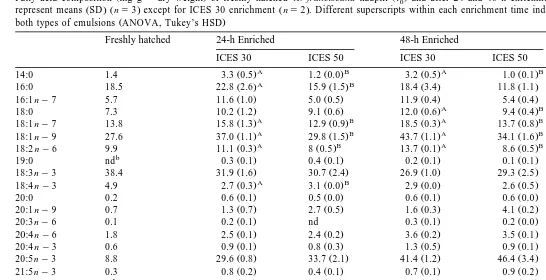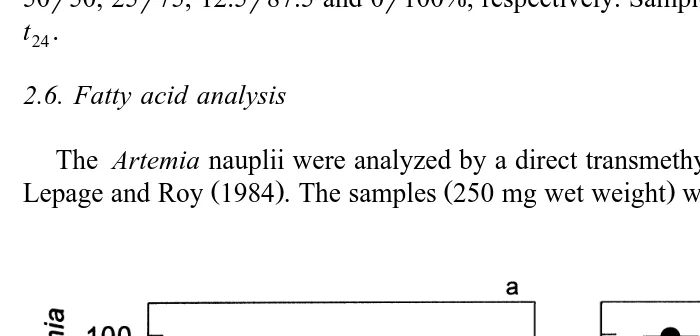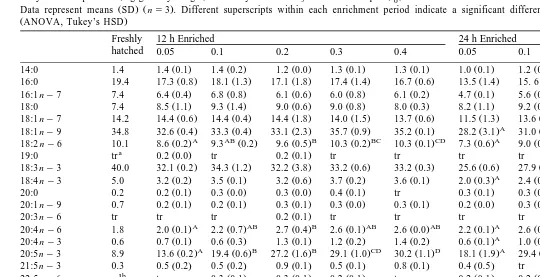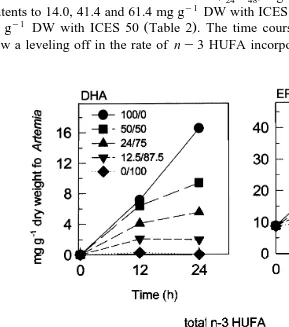www.elsevier.nlrlocateraqua-online
Enrichment strategies for Artemia using emulsions
providing different levels of n
y
3 highly
unsaturated fatty acids
Kyungmin Han
), Inge Geurden, Patrick Sorgeloos
Laboratory of Aquaculture and Artemia Reference Center, UniÕersity of Ghent, Rozier 44, Ghent, Belgium
Accepted 20 August 1999
Abstract
Ž .
Three separate enrichment trials compared the ny3 highly unsaturated fatty acid HUFA
Ž .
levels in Artemia franciscana nauplii Great Salt Lake, USA as a function of the ny3 HUFA
Ž . Ž y1.
level in the emulsion 30% and 50% , the enrichment dose 0.05, 0.1, 0.2, 0.3 and 0.4 g l and
Ž
the degree of dilution of a high HUFA emulsion with an ny3 HUFA-free emulsion 100r0,
.
50r50, 25r75, 12.5r87.5 and 0r100, HUFA-richrHUFA-free, wrw . The standard emulsions were distributed by the International Council for the Exploration of the Sea, Working Group on
Ž .
the Mass Rearing of Juvenile Fish ICES . After the 48-h enrichment, the content of
docosahex-Ž . Ž .
aenoic acid DHA , eicosapentaenoic acid EPA and total ny3 HUFA increased to 23.1, 46.4
y1 Ž .
and 74.3 mg g DW, respectively, in Artemia enriched with ICES 50 50% ny3 HUFA and to
y1 Ž .
14, 41.4, 59.9 mg g DW in nauplii enriched with ICES 30 30% ny3 HUFA . After the 12-h enrichment, the highest enrichment level of DHA, EPA and total ny3 HUFA was observed at
y1 Ž y1 .
the 0.4 g l dose 12.7, 30.2 and 45.3 mg g DW, respectively . After the 24-h enrichment, the highest enrichment levels were, however, found at the 0.3 g ly1dose, i.e., respectively, 28.9, 53.2 and 85.6 mg gy1 DW as compared to 21.7, 51.1 and 75.9 mg gy1 DW at the 0.4 g ly1 dose. After 12 h enrichment, no significant difference in ny3 HUFA levels was found among the 100r0, the 50r50 and the 25r75 treatments. After 24 h enrichment, the content of DHA in
Ž y1 .
nauplii of the 100r0 treatment was twice that of the 50r50 treatment 20.2 vs. 9.3 mg g DW , which was in turn five times higher than in the 12.5r87.5 treatment.q2000 Elsevier Science
B.V. All rights reserved.
Ž . Ž .
Keywords: Artemia; ny3 Highly unsaturated fatty acid HUFA ; Docosahexaenoic acid DHA ;
Eicosapen-Ž .
taenoic acid EPA ; Enrichment
)Corresponding author. Tel.:q32-9-264-3754; fax:q32-9-264-4193; e-mail: [email protected]
0044-8486r00r$ - see front matterq2000 Elsevier Science B.V. All rights reserved. Ž .
K. Han et al.rAquaculture 183 2000 335–347
336
1. Introduction
The brine shrimp Artemia is widely used as a live food organism for marine fish and crustacean larvae in commercial hatcheries. Freshly hatched Artemia nauplii contain
Ž .
very low levels of ny3 highly unsaturated fatty acids HUFA , being especially Ž .
deficient in docosahexaenoic acid DHA . The importance of dietary DHA for proper Ž
development of marine fish larvae has been documented repeatedly Kanazawa, 1993; .
Watanabe, 1993; Reitan et al., 1994 . In order to overcome the lack of ny3 HUFA in Artemia nauplii, various enrichment techniques have been developed to enhance their ny3 HUFA content. The degree of success in modifying the fatty acid profile of the nauplii has been shown to be influenced by the type of the enrichment diet, the enrichment conditions and the Artemia strain itself. Examples of practical and
experi-Ž . Ž
mental enrichment diets are unicellular algae Watanabe et al., 1980 , emulsion Leger et
´
. Ž .
al., 1987; McEvoy et al., 1996 , liposomes Ozkizilick and Chu, 1994 and
microencap-Ž .
sulated diets Southgate and Lou, 1995 . The lipid sources in these diets differ in lipid
Ž .
class composition McEvoy et al., 1996; Tocher et al., 1997 , ny3 HUFA content ŽDhert et al., 1993; Evjemo et al., 1997 and DHA. reicosapentaenoic acid EPA ratioŽ . ŽNaess et al., 1995; Evjemo et al., 1997 . Differences in enrichment conditions are. related to the salinity of the culture medium, the concentration of experimental emulsion ŽRees et al., 1994 , the enrichment duration Narciso et al., 1999 and the temperature. Ž .
Ž
following starvation Danielsen et al., 1995; Triantaphyllidis et al., 1995; Evjemo et al., .
1997 . Also, the species and geographical origin of the Artemia affect the success of the
Ž .
enrichment procedure Triantaphyllidis et al., 1995; Evjemo et al., 1997 . The lack of a standardized enrichment strategy mostly renders a comparison of results obtained in the
Ž .
large number of Artemia enrichment studies impossible Coutteau and Mourente, 1997 . The present study evaluates differences in the ny3 HUFA incorporation in Artemia nauplii related to the enrichment strategies. These differed in the ny3 HUFA content of the diet, the supplied dose and the dilution of ny3 HUFA-rich by ny3 HUFA-free emulsion.
2. Materials and methods
2.1. Hatching of Artemia cysts
Ž .
Artemia franciscana cysts ARC No: 1320, INVE Aquaculture, Belgium from Great
Ž . Ž y1.
Salt Lake UT, USA were used in each of the three experiments. The cysts 4 g l were disinfected with a hypochlorine solution of 200mg ly1 for 20 min before hatching.
Ž y1. After washing with tap water to remove the remaining hypochlorite, the cysts 2 g l
Ž .
were incubated in filtered seawater 0.45mm cartridge filter at 288C under continuous
Ž .
aeration and light. After hatching, the nauplii more than 90% Instar I were separated
Ž .
2.2. Enrichment experiments
Ž
The standard enrichment emulsions International Council for the Exploration of the .
Sea, Working Group on the Mass Rearing of Juvenile Fish; ICES, 1994 contained 30%
Ž .
and 50% of total ny3 HUFA percentage dry matter with DHArEPA ratio of 0.73 Ž
and 0.84, respectively ICES 30r0.6rC: ICES 30 and ICES 50r0.6rC: ICES 50,
. Ž .
respectively and an emulsion devoid of ny3 HUFA ICES 0r–rC: ICES 0 . The
Ž . Ž . Ž .
experimental emulsion contained percentage wet weight lipids 62% , water 30% , emulsifiers, antioxidants and liposoluble vitamins. The fatty acid compositions of the ICES emulsions are shown in Table 1. Temperature and salinity during the enrichment were 288C and 34 g ly1. Each enrichment experiment was performed in triplicate cones.
Table 1
Ž y1 .
The fatty acid composition mg g dry weight of ICES experimental emulsions containing approximately
Ž .
50%, 30% and no ny3 HUFA ICES 50, ICES 30 and ICES 0, respectively
ICES 50r0.6rC ICES 30r0.6rC ICES 0r–rC
Sums include minor fatty acid not shown in table.
b
nd: not detected.
c
()
Fatty acid composition mg g dry weight of freshly hatched A. franciscana nauplii t0 and after 24 and 48 h enrichment with emulsions ICES 50 and ICES 30. Data
Ž . Ž . Ž . Ž .
represent means SD ns3 except for ICES 30 enrichment ns2 . Different superscripts within each enrichment time indicate a significant difference P-0.05 between
Ž .
both types of emulsions ANOVA, Tukey’s HSD
a
Freshly hatched 24-h Enriched 48-h Enriched Effect of enrichment time
ICES 30 ICES 50 ICES 30 ICES 50 ICES 30 ICES 50
A B A B
2.3. Experiment 1
Emulsions ICES 50 and ICES 30 were used for comparing their HUFA enrichment Ž y1.
efficiency. The emulsions were fed 0.2 g l 0, 12, 24 and 36 h after hatching, i.e., t ,0
t , t12 24 and t . The Artemia nauplii were transferred to clean water after 24 h36
enrichment before the additional enrichment. Samples were harvested at t , t , t , t0 12 24 36 and t .48
2.4. Experiment 2
Different doses of ICES 50 were fed to evaluate effects of feeding concentration.
Ž y1.
Five concentrations 0.05, 0.1, 0.2, 0.3 and 0.4 g l were tested. The emulsion was fed
Ž . Ž .
at the beginning of enrichment t0 and after 12 h t12 . Samples were taken at t , t , t ,0 3 6 t12 and t .24
2.5. Experiment 3
Ž .
Two ICES emulsions ICES 50 and ICES 0, free of ny3 HUFA were mixed and Ž y1.
fed at t and t0 12 0.2 g l . The mixture ratios of ICES 50 to ICES 0 were 100r0, 50r50, 25r75, 12.5r87.5 and 0r100%, respectively. Samples were taken at t , t0 12 and t .24
2.6. Fatty acid analysis
The Artemia nauplii were analyzed by a direct transmethylation method according to
Ž . Ž .
Lepage and Roy 1984 . The samples 250 mg wet weight were rinsed with tap water to
Ž y1 .
Fig. 1. Changes in the contents mg g dry weight of DHA, EPA and total ny3 HUFA in A. franciscana
Ž . Ž .
()
Fatty acid composition mg g dry weight of freshly hatched A. franciscana nauplii t0 and after 12 and 24 h enrichment with different feeding concentrations of ICES 50.
Ž . Ž . Ž .
Data represent means SD ns3 . Different superscripts within each enrichment period indicate a significant difference P-0.05 according to the enrichment doses
ŽANOVA, Tukey’s HSD.
Freshly 12 h Enriched 24 h Enriched
hatched 0.05 0.1 0.2 0.3 0.4 0.05 0.1 0.2 0.3 0.4
Ž . remove the residual emulsion. The internal standard was eicosadienoic acid 20:2 ny6 for analyzing the Artemia nauplii and 23:0 for the emulsions. Fatty acid methyl esters ŽFAME. were separated by gas chromatography with on-column injection into a
Ž .
Chrompack CP 9001 with a polar column BPX 70 . The carrier gas was hydrogen and detection mode FID. The Maestro Chrompack program was used to integrate the chromatogram.
2.7. Statistical analysis
Data represent means of triplicate analyses, except for the fatty acid enrichment with Ž .
ICES 30r0.6rC in Table 2 ns2 . Data are analyzed by a one-way ANOVA followed
Ž . Ž .
by Tukey’s Honest Significant Difference test P-0.05 Sokal and Rohlf, 1981 .
Ž y1 .
()
Fatty acid composition mg g dry weight of freshly hatched A. franciscana nauplii t0 and after 12 and 24 h enrichment with various ratios of ICES 50 and ICES 0
Ž . Ž . Ž .
emulsions. Data represent means SD ns3 . Different superscripts within each enrichment period indicate a significant difference P-0.05 according to the ratio of ICES
Ž .
50rICES 0 ANOVA, Tukey’s HSD
Freshly 12 h Enriched 24 h Enriched
hatched 100r0 50r50 25r75 12.5r78.5 0r100 100r0 50r50 25r75 12.5r78.5 0r100
3. Results
3.1. Experiment 1
The results of the fatty acid enrichment kinetics in the nauplii when feeding emulsions ICES 50 and ICES 30 are shown in Fig. 1. The initial values of DHA, EPA and total ny3 HUFA in the freshly hatched Artemia nauplii were 0.1, 8.8 and 10.4 mg gy1 DW. The respective levels increased to 11.2, 29.6, 44.1 mg gy1 DW after 24 h enrichment with ICES 30 and to 16.0, 33.7 and 54.0 mg gy1 DW after 24 h enrichment
Ž .
with ICES 50. The additional enrichment t –t24 48 significantly increased the respective contents to 14.0, 41.4 and 61.4 mg gy1 DW with ICES 30 and up to 23.1, 46.4 and 77.4
y1 Ž .
mg g DW with ICES 50 Table 2 . The time course changes represented in Fig. 1 show a leveling off in the rate of ny3 HUFA incorporation.
Ž y1 .
K. Han et al.rAquaculture 183 2000 335–347
344
3.2. Experiment 2
The fatty acid enrichment results when supplying varying doses of ICES 50 are Ž .
shown in Table 3 and Fig. 2. During the first enrichment t –t0 12 , the highest ny3 HUFA levels were found in nauplii fed the highest concentrations, without significant
Ž . y1
difference P-0.05 between the 0.3 and 0.4 g l doses. After the second enrichment Žt –t ., the DHA level in nauplii fed the 0.3 g ly1 dose 28.9 mg gŽ y1 DW was.
12 24
y1 Ž y1 .
significantly higher than that of nauplii fed the 0.4 g l dose 21.7 mg g DW which
y1 Ž y1
in turn was similar to the DHA level in nauplii of the 0.2 g l treatment 23.1 mg g .
DW . This was not the case for EPA values which were the highest in nauplii of the 0.3 and 0.4 g ly1 concentrations.
3.3. Experiment 3
Table 4 and Fig. 3 show the modifications in the fatty acid profiles following the enrichment with different mixtures of ICES 50 and ICES 0. During the first enrichment
Ž .
period t –t0 12 , Artemia nauplii had a DHA, EPA and total ny3 HUFA content of 7.1,
y1 Ž
25.9 and 36.6 mg g DW, respectively, in the 100r0 treatment 100% ICES 50 and
. y1
0% ICES 0 , similar to the levels of, respectively, 6.3, 26.2 and 35.8 mg g DW in the
Ž .
50r50 treatment 50% ICES 50 and 50% ICES 0 . After the second enrichment Žt –t12 24., the amounts of DHA, EPA and total ny3 HUFA were 20.2, 47.1 and 73.3 mg gy1 DW in the 100r0 treatment, as compared to only 9.3, 37.6 and 51.5 mg gy1
Ž .
DW in 50r50 treatment. From the 0r100 treatment solely fed ICES 0 , the levels of DHA, EPA and total ny3 HUFA in Artemia nauplii were not statistically different ŽP)0.05 from those in the freshly hatched Artemia nauplii..
4. Discussion
The present study used standards of emulsified lipids providing different ny3 HUFA levels for examining the kinetics and level of essential ny3 HUFA incorpora-tion in A. franciscana. In order to facilitate comparisons among studies using enriched
Artemia nauplii for determining ny3 HUFA requirements of various marine fish
species, the Working Group on Mass Rearing of Larval and Juvenile Marine Fish of ICES has developed a series of standard emulsions.
Although of prime interest for studies on ny3 HUFA requirements of marine fish larvae, few studies have expressed the HUFA content of enriched Artemia in quantita-tive amounts. The highest DHA value detected in the present study after 24 h enrichment was 28.9 mg gy1 DW, using the 50% ny3 HUFA emulsion at 0.3 g ly1. This is intermediate between the value of 36 mg DHA gy1 DW found by Evjemo et al. Ž1997 and the value of 21.0 mg DHA g. y1 DW of 24-h enriched A. franciscana
Ž .
reported by Coutteau and Mourente 1997 both using an ICES emulsion containing
Ž y1 .
the importance of standardizing enrichment protocols in order to facilitate comparisons among different enrichment studies.
The geographical origin of the Artemia species, the enrichment diet and the Ž
enrichment conditions initial development stage of nauplii, enrichment time, dose and .
type of emulsion are the most obvious factors known to influence the enrichment
Ž .
results Leger et al., 1987 . However, other unknown factors seem to interfere. In the
´
present study, for instance, one treatment was precisely repeated in each of the enrichment trials, i.e., a 24-h enrichment with ICES 50 at a dose of 0.2 g ly1. Despite the fact that the A. franciscana, of same origin and batch, were hatched, enriched, sampled and analyzed under identical conditions, a discrepancy in enrichment levels was noted among the three trials with levels ranging from 16 to 23.1 mg gy1 DW for DHA, from 33.7 to 47.1 mg gy1 DW for EPA and 52.5 to 73.3 mg gy1 DW for ny3 HUFA. The fatty acid level in the Artemia nauplii is the result of rapid and complex metabolic processes of absorption, incorporation into body lipids and catabolism. It is well documented in marine vertebrates such as fish that ny3 HUFA levels correlate
Ž .
well with dietary ny3 HUFA supply Sargent et al., 1993 . Also in the present study, within each enrichment trial, differences in the amount of exogenously supplied DHA were reflected in the nauplii whole body. The ny3 HUFA metabolism in A. francis-cana contrasts, however, with that in most marine vertebrates, and even marine invertebrates such as copepods, in that they appear to store DHA principally in the
Ž triglyceride fraction from where it is very rapidly catabolized during starvation Barclay and Zeller, 1996; Coutteau and Mourente, 1997; Estevez et al., 1998; Navarro et al.,
´
.
1999 . The similar or even lower DHA level when supplying a concentration of 0.4 g ly1 as compared to, respectively, 0.2 or 0.3 g ly1 in the present study suggests the catabolism of DHA by the Artemia also during the feeding process. Using radiolabelled
Ž . 14
DHA, Navarro et al. 1999 demonstrated that almost 20% of the C DHA radioactivity was recovered in EPA after a 24-h Artemia enrichment. For present EPA levels, it was not possible to differentiate whether they originated from retroconversion of DHA or directly from the diet. But, the leveling off of DHA uptake at the high dose of 0.4 g ly1 was also seen for EPA, showing a regulatory mechanism for the maximum uptake of both ny3 HUFA. A possibility not verified here is that at the high doses autoxidation may have caused a reduction of the available HUFA in the enrichment medium, despite
Ž .
the antioxidant-protection of the ICES emulsions McEvoy et al., 1995 .
Summarizing the present data on improvement of the nutritional value of Artemia nauplii for marine larviculture, it was seen that higher DHA values were obtained with ICES 50 than with an ICES 30 ny3 HUFA emulsion at an optimal feeding concentra-tion of 0.2–0.3 g ly1 and without any dilution with a HUFA-free emulsion. A 24-h enrichment approximately doubled total ny3 HUFA levels as compared to a 12-h enrichment.
Acknowledgements
Ž .
K. Han et al.rAquaculture 183 2000 335–347
346
References
Barclay, W., Zeller, S., 1996. Nutritional enhancement of ny3 and ny6 fatty acids in rotifers and Artemia nauplii by feeding spray-dried Schizochytrium sp. J. World Aquacult. Soc. 27, 314–322.
Coutteau, P., Mourente, G., 1997. Lipid classes and their content of ny3 highly unsaturated fatty acids
ŽHUFA in Artemia franciscana after hatching, HUFA-enrichment and subsequent starvation. Mar. Biol..
130, 81–91.
Danielsen, T.L., Evjemo, J.O., Olsen, Y., 1995. Stability of short-term enriched ny3 fatty acids in Artemia
Ž .
during starvation at different temperatures. In: Lavens, P., Jaspers, E., Roelants, I. Eds. . Larvi 95 Fish and Shellfish Symposium. European Aquaculture Society, Special Publication No. 24, pp. 128–131. Dhert, P., Sorgeloos, P., Devresse., 1993. Contribution towards a specific DHA enrichment in the live food
Brachionus plicatilis and Artemia sp. In: Reinersten, H., Dahle, L.A., Jorgensen, L., Tvinnereim, K. ŽEds. . Preceeding of the first International Conference on Fish Farming Technolgy. Trodheim, Norway,.
9–12 August 1993, A.A. Balkema, Rotterdam, pp. 109–115.
Estevez, A., McEvoy, L.A., Bell, J.G., Sargent, J.R., 1998. Effects of temperature and starvation time on the´ pattern and rate of loss of essential fatty acids in Artemia nauplii previously enriched using arachidonic acid and eicosapentaenoic acid-rich emulsion. Aquaculture 165, 295–311.
Evjemo, J.O., Coutteau, P., Olsen, Y., Sorgeloos, P., 1997. The stability of DHA in two Artemia species following enrichment and subsequent starvation. Aquaculture 155, 135–148.
ICES, 1994. Report of ICES Working Group on Mass Rearing of Juvenile Marine Fish. Internat. Counc. Explor. Sea, Committee Meeting, Mariculture Comm. F, 6.
Kanazawa, A., 1993. Importance of dietary docosahexaenoic acid on growth and survival of fish larvae. In:
Ž .
Lee, C.S., Su, M.S., Liao, I.C. Eds. . Finfish Hatchery in Asia: Proceeding of finfish Hatchery in Asia 91. TML Conference Proceeding 3, pp. 87–95.
Leger, Ph., Naessens-Foucquaert, E., Sorgeloos, P., 1987. International study on Artemia XXXV. Techniques´ to manipulate the fatty acid profile in Artemia nauplii and the effect on its nutritional effectiveness for the
Ž .
marine crustacean Mysidopsis bahia M . In: Sorgeloos, P., Bengtson, D.A., Decleir, W., Jaspers, E.
ŽEds. , Artemia Research and its Applications, Vol. 3. Ecology, Culturing, Use in Aquaculture. Universa.
Press, Wetteren, Belgium, pp. 411–424.
Lepage, G., Roy, C.C., 1984. Improved recovery of fatty acids through direct transesterification without prior extraction or purification. J. Lipid Res. 16, 593–600.
McEvoy, L.A., Navarro, J.C., Bell, J.G., Sargent, J.R., 1995. Autoxidation of oil emulsion during the Artemia enrichment process. Aquaculture 134, 104–112.
McEvoy, L.A., Navarro, J.C., Hontario, F., Amat, F., Sargent, J.R., 1996. Two novel Artemia enrichment diets containing polar lipid. Aquaculture 144, 339–352.
Ž .
Naess, T., Germail-Henry, M., Nass, K.E., 1995. First feeding of Atlantic halibut Hippoglossus hippoglossus using different combination in the first stages of Artemia sp. Mar. Biol. 111, 461–465.
Narciso, L., Pousao-Ferreira, P., Passos, A., Luıs, O., 1999. HUFA content and DHA˜ ´ rEPA improvements of
Artemia sp. with commercial oils during different enrichment periods. Aquacult. Res. 30, 21–24.
Navarro, J.C., Henderson, R.J., McEvoy, L.A., Bell, M.V., Amat, F., 1999. Lipid conversion during enrichment of Artemia. Aquaculture 174, 155–166.
Ozkizilick, S., Chu, F.E., 1994. Uptake and metabolism of liposomes by Artemia nauplii. Aquaculture 128, 131–141.
Reitan, K.I., Rainuzzo, J.R., Olsen, Y., 1994. Influence of lipid composition of live feed on growth, survival and pigmentation of turbot larvae. Aquacult. Int. 2, 33–48.
Rees, J.F., Cure, K., Piyatiratitivorakul, S., Sorgeloos, P., Menasveta, P., 1994. Highly unsaturated fatty acid requirements of Penaeus monodon postlarvae: an experimental approach based on Artemia enrichment. Aquaculture 122, 193–207.
Sargent, J.R., Bell, J.G., Bell, M.V., Henderson, R.J., Tocher, D.R., 1993. The metabolism of phospholipids
Ž .
and polyunsaturated fatty acids in fish. In: Lahlou, B., Vitiello, P., Eds. , Aquaculture: Fundamental and Applied Research. Coastal and Estuarine Studies. American Geophysical Union, Washington, DC, pp. 103–124.
Southgate, P.C., Lou, D.C., 1995. Improving the ny3 HUFA composition of Artemia using microcapsules containing marine oil. Aquaculture 134, 91–99.
Tocher, D.R., Mourente, G., Sargent, J.R., 1997. The use of silages from fish neural tissues as enrichers for
Ž .
rotifers Brachonus plicatilis and Artemia in the nutrition of larval marine fish. Aquaculture 148, 213–231.
Triantaphyllidis, G.V., Coutteau, P., Sorgeloos, P., 1995. The stability of ny3 highly unsaturated fatty acids in various Artemia populations following enrichment and subsequent starvation. In: Lavens, P., Jaspers,
Ž .
E., Roelants, I. Eds. . Larvi 95 Fish and Shellfish Symposium. European Aquaculture Society, Special Publication No. 24, pp. 149–153.
Watanabe, T., 1993. Importance of docosahexaenoic acid in marine larval fish. J. World Aquacult. Soc. 24, 152–161.
Watanabe, T., Oowa, F., Kitajima, C., Fujita, S., 1980. Relationship between dietary value of brine shrimp






